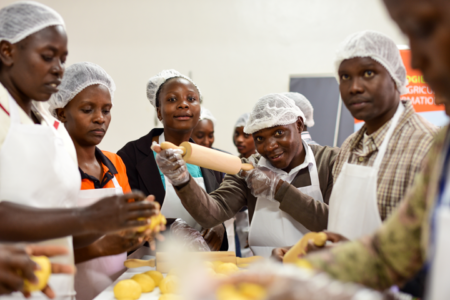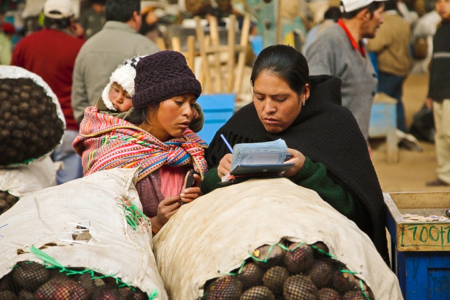
While demand for potatoes is expanding throughout sub-Saharan Africa, productivity is still limited by a lack of clean, disease-free planting materials. This project seeks to boost food security and incomes among smallholder potato farmers by tackling one of their chief constraints—bacterial wilt disease—through introducing better disease detection tools and enhanced genetic resistance.
Background
Potato is an ideal food security crop to grow in challenging conditions, since it is highly efficient in transforming water into calories, has a short maturity period, and can be harvested over a relatively long period of time. However, because many farmers use part of their own potato harvest as planting stock for the following season, or obtain uncertified stock locally, viruses and diseases tend to build up over successive years, adversely affecting yields. Persistent low productivity discourages smallholders from expanding their potato production; this is a missed opportunity, since there is growing demand for potatoes from rising numbers of urban consumers, fast-food restaurants and processing companies.
The project seeks to reduce the current gap between supply and demand by addressing the problem of bacterial wilt disease, which is among the key constraints impeding growth of the potato value chain in sub-Saharan Africa. The initiative complements several other projects led by the International Potato Center (CIP) that support engagement of the private sector and national research systems in increasing the availability of quality, disease resistant potato planting materials.
Objectives
- Enhance potato productivity and boost the food security of small-scale potato farmers. Implemented initially in Kenya and Uganda, the project will be rolled out for further dissemination throughout subSaharan Africa.
Approach
The project will improve access to quality seed potato with resistance to bacterial wilt through the introduction of new diagnostic tools that can be used by the national phytosanitary authorities and private sector seed potato producers. The most immediate need is to identify the distribution and diversity of the bacterial pathogen in Kenya and Uganda and to improve diagnostic detection. These activities will be supported by capacity building with phytosanitary services to enable them to prevent further spread of the disease. Over the longer term, the project seeks to address the solution of host plant resistance to bacterial wilt disease.
Enhanced potato productivity will benefit male and female farmers alike. However, potato is currently grown predominantly by women and provides a valuable source of cash for family needs. Hence this project will seek to contribute to women’s empowerment and involvement in family decision-making.
Expected outcomes
Project activities will result in short-term and long-term impacts by delivering new disease detection tools and genetic resistance to disease. Both bacterial-wilt-disease control approaches make use of state-of-the-art molecular and genome editing techniques. The first outcome is the production of a distribution and diversity map of bacterial wilt in Kenya and Uganda. This will help identify ‘hotspots’ where seed potato movement needs to be controlled. Secondly, the team will develop new diagnostic tools and sampling methods that can be used in the field to identify bacterial wilt disease. Capacity building for the national phytosanitary services and agricultural research systems will expand the team of in-country specialists in bacterial wilt research, diagnostics, host plant resistance and genome editing. The final stages of the project will develop host plant resistance in potato by importing genes from other related crops, and conducting extensive greenhouse testing. This will result in new bacterial wiltresistant potato varieties.
Small-scale potato farmers will be the main beneficiaries. With disease-resistant planting stock, they will be able to increase their productivity and incomes. Seed regulatory agencies will benefit by having a more reliable and user-friendly monitoring method to use in the field and at border posts. Over the long term, around 400,000 Kenyan and 250,000 Ugandan farmers (45% of those currently facing yield losses due to bacterial wilt) will benefit from adopting improved varieties.
Key outputs
| Outcome | Number |
| The number of farmers using certified seed in Kenya | 10,000 |
Contact
Kalpana Sharma
CIP, Kenya
kalpana.sharma@cgiar.org
Thanks to our donors



